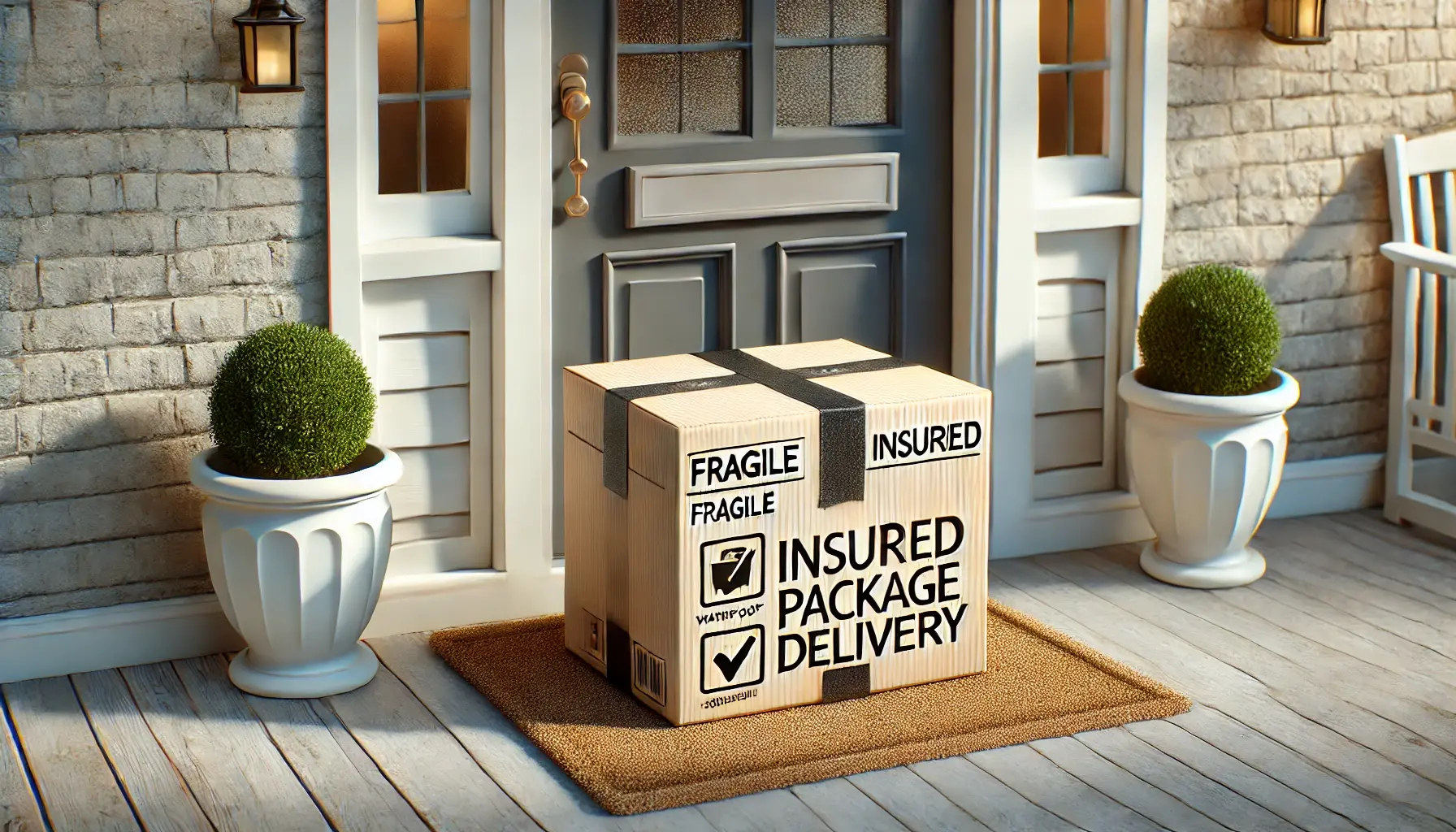

For the latest on ecommerce tips and best practices.
How to Prevent Porch Piracy and Handle Stolen Packages

A customer places an order online, and your business picks, packs, and ships the order. A few days later, it’s dropped off right at the buyer’s doorstep. It’s a perfect delivery—but unfortunately, a porch pirate could come along to throw a wrench in things. Read on to learn what porch pirates are, how they affect your business, and what you can do to stop them.
What are porch pirates?
Porch pirates are thieves who steal packages that have been delivered to homeowners’ front porches, doorsteps, or mailboxes. As online shopping becomes more prevalent, porch piracy has become more common, taking advantage of packages left unattended. They often follow delivery trucks and strike shortly after a package has been delivered. And sometimes, they even pose as legitimate delivery drivers to steal packages without arousing suspicion.
Porch piracy is a big problem: 36% of Americans have had at least one package stolen during their lifetime, and 49 million consumers had a package stolen in 2021 alone. Despite this, only eight states currently charge package theft as a felony.
Unfortunately, it’s difficult to catch porch pirates. If victims don’t have any evidence (such as footage from a video doorbell) police might not be able to do anything to help. With few reliable ways to catch porch pirates, porch piracy is a headache for businesses and consumers alike.
What are porch pirates looking for?
Porch pirates look for small packages (which are easier to steal) that contain expensive items they can sell. In their hunt for high-value products, they tend to focus on deliveries with flashy packaging, including name brands. Ultimately, though, porch pirates are opportunists—they steal whatever they can get their hands on in the hopes that they find something worth taking.
How do porch pirates affect your business?
Even though you don’t have control over package theft, porch pirates can negatively affect your business’s bottom line by harming your reputation, damaging customer trust, and increasing costs.
- Lost revenue. In general, carriers won’t take action if a package is stolen—once a delivery is successful, it’s out of their hands. This leaves retailers to shoulder the financial burden of replacing items or refunding customers. It’s totally optional, of course, but failing to offer replacements or refunds could negatively impact customer retention. How much money is lost in porch piracy depends from case to case on many factors such as the value of the items stolen, shipping methods used, ecommerce store policies, etc.
- Higher shipping and insurance costs. Insurance can help you avoid the financial burden of package theft, but it still comes with an upfront cost. Putting anti-theft measures in place (see the next section for ideas) can also require that you spend more money.
- Increased customer service workload. Customer complaints, inquiries, and refund or replacement requests may create additional strain on your customer service team.
- Decreased trust and brand loyalty. Consumers are already cautious about online shopping; one survey found that 41% of respondents avoid buying high-value products online due to fear of theft. If customers have a bad experience with your brand in particular, they might be wary of buying from you again.
- Damaged reputation. Customers who have things stolen by porch pirates might leave negative reviews online or advise their friends and family members to avoid buying from you.
Understanding how porch pirates operate can help you take proactive measures to protect your customers' purchases. Large purchasing days, such as Amazon Prime Day, Black Friday, or Cyber Monday, usually see a spike in stolen deliveries, with Amazon packages being the most likely to be stolen. Package theft is most common in urban areas, where 34% of adults have had at least one package stolen. That number drops to 20% for those living in suburban areas and 13% for rural areas. Nevertheless, it is a prevalent problem for many ecommerce businesses and their customers. So let’s review what to do about porch pirates.
How to prevent porch pirates
In one study, nearly half of respondents reported that they don’t believe that delivery companies and retailers are doing enough to prevent package theft. But how can you prevent porch piracy? Fostering transparency, offering insurance, and providing secure delivery options can help you thwart porch pirates and boost customer confidence.
Give clear delivery dates
Many people will go to great lengths to make sure they’re at home when their order arrives. Twenty percent of adults have even taken a day off work to collect a delivery in person! But if delivery dates are unclear, people might not be able to pick up their order before a porch pirate gets to it. The solution? Ensure that delivery dates (and times) are clear and correct.
Provide tracking when possible
Having clear delivery dates and times is crucial, but it’s even better to offer real-time package tracking. With package tracking, online shoppers are informed of every move their package makes, so they know exactly when it will arrive. With 91% of Americans actively tracking their packages, foregoing this feature might lead to customer frustration or stress.
Offer shipping insurance
Shipping insurance doesn’t prevent theft, but it makes it easier to recover from it. If an insured order gets lost, stolen, damaged, or mishandled, the insurance provider will cover the cost. You can offer seller insurance, which is covered by the business, or buyer insurance, which is optional and paid for by the customer. For example, Norton Shopping Guarantee with Package Protection is a shopping guarantee plus insurance available for Shopify merchants to offer to their customers.
Allow for in-store pickup
If you have physical retail locations, consider allowing customers to pick up their online orders from the store (or another location). Customers who aren’t at home during the day will appreciate the option to have their package delivered to a secure environment.
Require acceptance signatures
Requiring an acceptance signature or signature proof of delivery means that the package can’t be dropped off at the doorstep; somebody has to be home to sign for it. Some people might find acceptance signatures inconvenient, but for high-value orders like electronics and jewelry, it’s better safe than sorry. Keep in mind that some carriers charge an additional fee for this service.
Avoid flashy packaging
For porch pirates, each package is a gamble. Will they find something inside that was worth stealing? To maximize their chances of making money, porch pirates tend to focus on packages with flashy packaging, including name brands. If you send out packages with visible branding, consider switching gears. Save the branding for the inside of the box, and make the outside as plain as possible so it won’t attract too much attention.
Package size comes into play here as well. It’s best to avoid packing small items in oversized packages, as this can make them more noticeable.
What to do if a package is stolen
Now you are prepared to protect yourself and customers against porch piracy, let’s look next at how to deal with porch piracy that has already taken place.If a porch pirate steals a package, you should contact the carrier for more information, thoroughly investigate, and make sure the customer gets a replacement or refund.
Step 1: Express sincere concern
After having a package snagged by a porch pirate, customers are probably feeling frustrated and disappointed. The way your business reacts will go a long way toward rebuilding a good relationship with them. Express sincere concern (even if the theft wasn’t your fault) and reassure the customer that you’ll do everything you can to make things right. Be empathetic and acknowledge that they’re going through a stressful experience.
Step 2: Investigate the theft
After communicating with the customer, reach out to the delivery carrier to verify the order delivery status, and ask for any specific notes or updates. Next, make sure the order was sent to the correct address. If a mistake occured in the system, the package might be safe and sound—but in the wrong place. Once you’ve determined that the package was really stolen, verify its contents and determine its value.
If you have shipping insurance, reach out to the insurance provider to file a claim. If possible, ask the customer to provide evidence that their order was stolen, such as pictures of the package delivery or a confirmation message. Work with the insurance carrier to resolve the claim in a timely manner, providing them with the package information and evidence of the theft.
As much as possible, keep the customer in the loop during the claims process. If you can, provide them with a point of contact they can reach out to if they have questions or concerns. It can also be helpful to share an FAQ page with details of your refunds and returns policy. Maintaining transparent communication is the best way to show that you’re committed to getting to the bottom of things.
Step 3: Reimburse the customer or send a replacement
Once you’ve completed the investigation, allow the customer to choose between a replacement product or a refund. If the buyer opts for a replacement, provide tracking information so they can trace its journey and make sure it arrives safely.
Add an extra layer of protection with the Norton Shopping Guarantee with Package Protection by EasyPost
Despite your best efforts to prevent porch piracy, you don’t have full control over your products’ shipment journeys. But you can add an extra layer of security to the buying experience with the Norton Shopping Guarantee with Package Protection by EasyPost. Available free to Shopify merchants, this purchase protection guarantee comes with built-in shipping insurance. Simply offer it to your customers as an option at checkout, and they can rest easy knowing that their order is safe from theft.
Get started now to protect your customers from porch pirates.
Stay in the know
Subscribe to the Norton Shopping Guarantee blog and receive the latest in ecommerce best practices.


.png)
